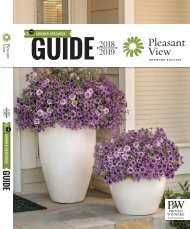- Page 1 and 2:
1 9 7 6 PVG G R O W E R R E S O U R
- Page 3 and 4:
LEGEND W H AT ’ S T H E L E G E N
- Page 5 and 6:
I N T RO PVG 2 0 1 9 2020 T H E P R
- Page 7 and 8:
N E W F O R 2 0 2 0 PVG 2 0 1 9 202
- Page 9 and 10:
Neptune N E W F O R 2 0 2 0 PVG SUP
- Page 11 and 12:
SHADOWLAND ® ‘Coast to Coast’
- Page 13 and 14:
PROVEN WINNERS ® Annuals N E W F O
- Page 15 and 16:
N E W F O R 2 0 2 0 PVG 2 0 1 9 202
- Page 17 and 18:
N E W F O R 2 0 2 0 PVG 2 0 1 9 202
- Page 19 and 20:
N E W F O R 2 0 2 0 PVG 2 0 1 9 202
- Page 21 and 22:
N E W F O R 2 0 2 0 PVG 2 0 1 9 202
- Page 23 and 24:
N E W F O R 2 0 2 0 PVG 2 0 1 9 202
- Page 25 and 26:
N E W F O R 2 0 2 0 PVG 2 0 1 9 202
- Page 27 and 28:
PROVEN WINNERS ® Perennials N E W
- Page 29 and 30:
PROVEN HARVEST Herbs, Vegetables,
- Page 31 and 32:
2020 DROP LIST RECOMMENDED SUBSTITU
- Page 33 and 34:
L I N E R G U I D E PVG 2 0 1 9 202
- Page 35 and 36:
L I N E R G U I D E 5 6 7 8 9 10 11
- Page 37 and 38:
ENHANCED Liners E N H A N C E D L
- Page 39 and 40:
3 2 E VA R I E T I E S ANGELFACE ®
- Page 41 and 42:
7 2 E VA R I E T I E S ANGELFACE ®
- Page 43 and 44:
S T R E A M L I N E R S T A G O P
- Page 45 and 46:
84 LINER TRAY (84) ANNUALS Liner Si
- Page 47 and 48:
50 DEEP LINER TRAY (50D) » Large p
- Page 49 and 50:
CORMS: CALADIUM (C1/C2/CJ) » Premi
- Page 51 and 52:
Another turn of Spring crops comes
- Page 53 and 54:
PREFINISHED » To guarantee shipmen
- Page 55 and 56:
R E C I P E G U I D E PVG 2 0 1 9 2
- Page 57 and 58:
Above & Beyond SUPERTUNIA VISTA ®
- Page 59 and 60:
Candyland SUPERBELLS ® DREAMSICLE
- Page 61 and 62:
Fall Twister SUPERBELLS ® Yellow C
- Page 63 and 64:
Hollandaise SUPERBELLS ® OVER EASY
- Page 65 and 66:
Morning Skies SUPERBELLS ® Double
- Page 67 and 68:
Regards To Broadway SUPERBELLS ® W
- Page 69 and 70:
Summer Candy SUPERBELLS ® Pink Cal
- Page 71 and 72:
Thrillers for Prefinished 12.0 Reci
- Page 73 and 74:
G O & G R O W K I T S PVG 2 0 1 9
- Page 75 and 76:
7 KIT PACKAGES G O & G R O W E N H
- Page 77 and 78:
QUICK TURNS, FAST FINISH, HIGHER PR
- Page 79 and 80:
6 STARTER KIT OPTIONS S T A R T E R
- Page 81 and 82:
24 VARIETIES IN A BOX! G O & G R O
- Page 83 and 84:
24 VARIETIES IN A BOX! G O & G R O
- Page 85 and 86:
G R O W Y O U R O W N A D V E N T U
- Page 87 and 88:
K I T I N C L U D E S Y O U R C H O
- Page 89 and 90:
GO & GROW CLEMATIS Kit G O & G R O
- Page 91 and 92:
S O L U T I O N S PVG 2 0 1 9 2020
- Page 93 and 94:
S O LU T I O N S PATTI’S PINK Iso
- Page 95 and 96:
S O LU T I O N S COLORBLAZE ® WICK
- Page 97 and 98:
S O LU T I O N S CAMPFIRE ® Flame
- Page 99 and 100:
S O LU T I O N S ENDLESS Flirtatio
- Page 101 and 102:
S O LU T I O N S LUSCIOUS ® GOLDEN
- Page 103 and 104:
S O LU T I O N S HEAT IT UP Yellow
- Page 105 and 106:
S O LU T I O N S GOLDILOCKS ROCKS
- Page 107 and 108:
S O LU T I O N S HIPPO ® Pink Hypo
- Page 109 and 110:
VA R I E T I E S THERE’S SOMETHIN
- Page 111 and 112:
ALTERNANTHERA PLUM DANDY Z: 10-11
- Page 113 and 114:
ANGELONIA A N N U A L S A 2 0 1 9 2
- Page 115 and 116:
ANGELONIA ANGELFACE ® Cascade Pink
- Page 117 and 118:
ARGYRANTHEMUM ARTEMISIA A N N U A L
- Page 119 and 120:
BEGONIA tuberhybrida ILLUMINATION
- Page 121 and 122:
BEGONIA tuberhybrida NONSTOP ® Moc
- Page 123 and 124:
BEGONIA A N N U A L S AB 2 0 1 9 2
- Page 125 and 126:
BRACHYSCOME hybrid BLUE ZEPHYR Z:
- Page 127 and 128:
FANCY LEAF TYPES CALADIUM A N N U A
- Page 129 and 130:
CALADIUM CALENDULA A N N U A L S LA
- Page 131 and 132:
SUPERBELLS ® HONEYBERRY Calibracho
- Page 133 and 134: CALIBRACHOA A N N UA L S CA 2 0 1 9
- Page 135 and 136: CALIBRACHOA CANNA A N N U A L S CA
- Page 137 and 138: CATHARANTHUS CHRYSOCEPHALUM A N N U
- Page 139 and 140: CLEOME A N N UA L S CA 2 0 1 9 2020
- Page 141 and 142: COLORBLAZE ® Chocolate Drop USPPAF
- Page 143 and 144: COLEUS A N N U A L S CA 2 0 1 9 2 0
- Page 145 and 146: COLOCASIA esculenta ROYAL HAWAIIAN
- Page 147 and 148: CUPHEA A N N U A L S CA 2 0 1 9 2 0
- Page 149 and 150: DAHLIA hybrid DALINA® Midi Series
- Page 151 and 152: DAHLIA DRACAENA A N N U A L S SILVE
- Page 153 and 154: DIAMOND FROST ® ‘Inneuphdia’ U
- Page 155 and 156: FUCHSIA hybrids SHADOW DANCERS ® S
- Page 157 and 158: GAURA GOMPHRENA TRUFFULA Pink A N N
- Page 159 and 160: HELICHRYSUM HEDERA HELIOTROPIUM A N
- Page 161 and 162: HIPPO ® Red G14157’ USPPAF, Can
- Page 163 and 164: A N N UA L S ROCKAPULCO ® ‘Balol
- Page 165 and 166: A N N UA L S AI 2 0 1 9 2020 INFINI
- Page 167 and 168: IMPATIENS IPOMOEA A N N U A L S AI
- Page 169 and 170: Sweet Caroline RED HAWK USPPAF, Can
- Page 171 and 172: Sweet Caroline RED HAWK Ipomoea IPO
- Page 173 and 174: ISOTOMA LAMIUM A N N U A L S AL 2 0
- Page 175 and 176: LUSCIOUS ® Lemonade ‘Robpwcrm’
- Page 177 and 178: LANTANA camara BANDANA ® Series Z:
- Page 179 and 180: LOBELIA A N N U A L S AL 2 0 1 9 2
- Page 181 and 182: WHITE KNIGHT ® ‘Inlbuwikni’ US
- Page 183: AROMANCE Pink ‘INNEMAROPI’ USP
- Page 187 and 188: OSTEOSPERMUM OXALIS A N N U A L S A
- Page 189 and 190: PELARGONIUM A N N U A L S AP 2 0 1
- Page 191 and 192: PENTAS A N N UA L S SUNSTAR Pink US
- Page 193 and 194: PETUNIA A N N U A L S AP 2 0 1 9 2
- Page 195 and 196: SUPERTUNIA ® Trailing Rose Veined
- Page 197 and 198: PETUNIA A N N UA L S AP 2 0 1 9 202
- Page 199 and 200: PETUNIA A N N UA L S SUPERTUNIA VIS
- Page 201 and 202: PETUNIA A N N UA L S AP 2 0 1 9 202
- Page 203 and 204: PETUNIA PLECTRANTHUS A N N U A L S
- Page 205 and 206: MOJAVE ® Pink Portulaca PORTULACA
- Page 207 and 208: SALVIA A N N UA L S AS 2 0 1 9 2020
- Page 209 and 210: WHIRLWIND ® Blue Improved USPPAF,
- Page 211 and 212: SEDUM reflexum Ember Reef Z: 3-10 H
- Page 213 and 214: SUTERA A N N U A L S AS 2 0 1 9 2 0
- Page 215 and 216: THUNBERGIA TORENIA A N N U A L S AT
- Page 217 and 218: TORENIA VERBENA A N N U A L S SUPER
- Page 219 and 220: SUPERBENA ROYALE ® VERBENA A N N U
- Page 221 and 222: A N N U A L S AV 2 0 1 9 2 0 2 0 VE
- Page 223 and 224: G R A S S E S PVG 2 0 1 9 2 0 2 0 G
- Page 225 and 226: GRACEFUL GRASSES ® Fiber Optic Gra
- Page 227 and 228: KNOWLEDGE PERSONAL ATTENTION SUPPOR
- Page 229 and 230: BASIL AMAZEL The first Downy Milde
- Page 231 and 232: TOMATO 'Garden Gem' STRAWBERRY TOMA
- Page 233 and 234: S AV O R E D I B L E S & F R A G R
- Page 235 and 236:
MINT ISLAND PINEAPPLE Hardy, pineap
- Page 237 and 238:
EGGPLANT Classic Standard black Gre
- Page 239 and 240:
TOMATO Gold Nugget Cherry yellow Le
- Page 241 and 242:
FROM THE OFFICE TO THE GREENHOUSE Y
- Page 243 and 244:
CLEMATIS hybrids Vernalized, heavil
- Page 245 and 246:
Rosa Konigskind Z: 4-9 HT 4-6' SP 2
- Page 247 and 248:
DIANTHUS P E R E N N I A L S DA 2 0
- Page 249 and 250:
LAKOTA Fire Echinacea US7982110 DIA
- Page 251 and 252:
HELIOPSIS HEUCHERA P E R E N N I A
- Page 253 and 254:
FUN AND GAMES ® Red Rover USPPAF C
- Page 255 and 256:
HOSTA P E R E N N I A L S HA 2 0 1
- Page 257 and 258:
LAMIUM AMAZING DAISIES ® DAISY MAY
- Page 259 and 260:
For Oxalis varieties, see Annuals S
- Page 261 and 262:
PHLOX SALIVIA P E R E N N I A L S A
- Page 263 and 264:
SEDUM STRAWBERRY P E R E N N I A L
- Page 265 and 266:
GROWING IS OUR BUSINESS OUR TRUE FO
- Page 267 and 268:
CARYOPTERIS x clandonensis BEYOND M
- Page 269 and 270:
HYDRANGEA paniculata BOBO ® Z: 3-8
- Page 271 and 272:
HYDRANGEA serrata TUFF STUFF Z: 5-
- Page 273 and 274:
SAMBUCUS racemosa LEMONY LACE Z: 3
- Page 275 and 276:
WEIGELA florida SONIC BLOOM ® Pear
- Page 277 and 278:
T H E P O W E R O F P R O V E N W I
- Page 279 and 280:
® PUT THE PROVEN WINNERS Brand to
- Page 281 and 282:
MORE WAYS WE Help You Grow Consumer
- Page 283 and 284:
A N N U A L S A N D P R O V E N H A
- Page 285 and 286:
O R D E R I N G G U I D E PVG 2 0 1
- Page 287 and 288:
ONLINE Ordering Visit http://picas.
- Page 289 and 290:
5 D E L I V E RY D A T E The date a
- Page 291 and 292:
BRANDED CONTAINER Options COLORCHOI
- Page 293 and 294:
TAG ORDERING Options O N E P L A N
- Page 295 and 296:
GROWER I I I . S H I P P I N G R E
- Page 297 and 298:
I N D E X SOMETHING YOUR PLANTS NEE
- Page 299 and 300:
Variety Description Page Number 32E
- Page 301 and 302:
Variety Description Page Number 32E
- Page 303 and 304:
GRASSES Variety Description Acorus
- Page 305 and 306:
WEEK NO. July 2019 S M T W T F S 27
- Page 307 and 308:
PLEASANT VIEW’S Grower-On-Call SE
















